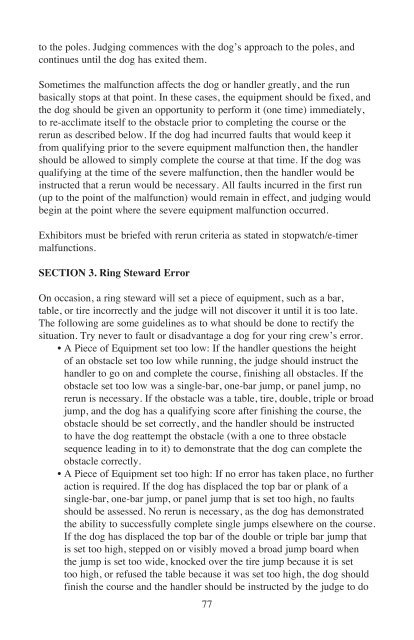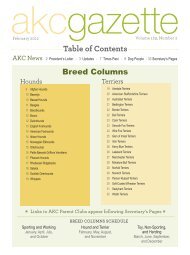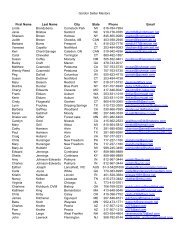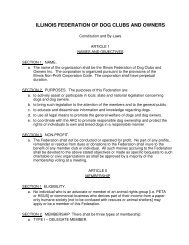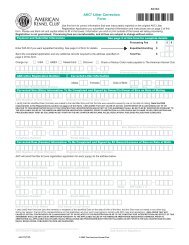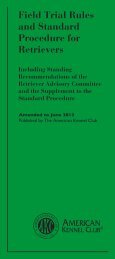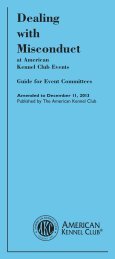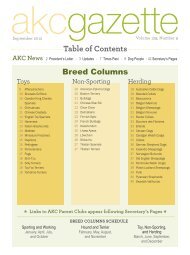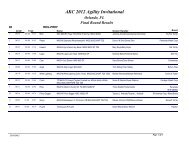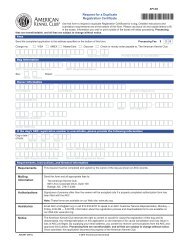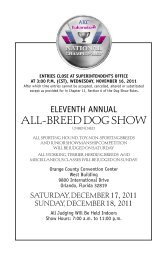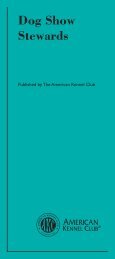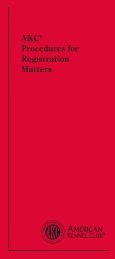Create successful ePaper yourself
Turn your PDF publications into a flip-book with our unique Google optimized e-Paper software.
to the poles. Judging commences with the dog’s approach to the poles, and<br />
continues until the dog has exited them.<br />
Sometimes the malfunction affects the dog or handler greatly, and the run<br />
basically stops at that point. In these cases, the equipment should be fixed, and<br />
the dog should be given an opportunity to perform it (one time) immediately,<br />
to re-acclimate itself to the obstacle prior to completing the course or the<br />
rerun as described below. If the dog had incurred faults that would keep it<br />
from qualifying prior to the severe equipment malfunction then, the handler<br />
should be allowed to simply complete the course at that time. If the dog was<br />
qualifying at the time of the severe malfunction, then the handler would be<br />
instructed that a rerun would be necessary. All faults incurred in the first run<br />
(up to the point of the malfunction) would remain in effect, and judging would<br />
begin at the point where the severe equipment malfunction occurred.<br />
Exhibitors must be briefed with rerun criteria as stated in stopwatch/e-timer<br />
malfunctions.<br />
Section 3. Ring Steward Error<br />
On occasion, a ring steward will set a piece of equipment, such as a bar,<br />
table, or tire incorrectly and the judge will not discover it until it is too late.<br />
The following are some guidelines as to what should be done to rectify the<br />
situation. Try never to fault or disadvantage a dog for your ring crew’s error.<br />
• A Piece of Equipment set too low: If the handler questions the height<br />
of an obstacle set too low while running, the judge should instruct the<br />
handler to go on and complete the course, finishing all obstacles. If the<br />
obstacle set too low was a single-bar, one-bar jump, or panel jump, no<br />
rerun is necessary. If the obstacle was a table, tire, double, triple or broad<br />
jump, and the dog has a qualifying score after finishing the course, the<br />
obstacle should be set correctly, and the handler should be instructed<br />
to have the dog reattempt the obstacle (with a one to three obstacle<br />
sequence leading in to it) to demonstrate that the dog can complete the<br />
obstacle correctly.<br />
• A Piece of Equipment set too high: If no error has taken place, no further<br />
action is required. If the dog has displaced the top bar or plank of a<br />
single-bar, one-bar jump, or panel jump that is set too high, no faults<br />
should be assessed. No rerun is necessary, as the dog has demonstrated<br />
the ability to successfully complete single jumps elsewhere on the course.<br />
If the dog has displaced the top bar of the double or triple bar jump that<br />
is set too high, stepped on or visibly moved a broad jump board when<br />
the jump is set too wide, knocked over the tire jump because it is set<br />
too high, or refused the table because it was set too high, the dog should<br />
finish the course and the handler should be instructed by the judge to do<br />
77


